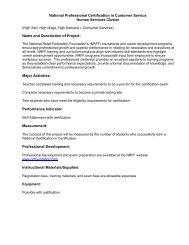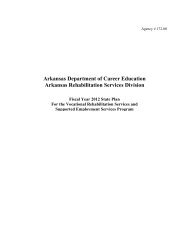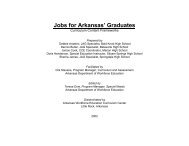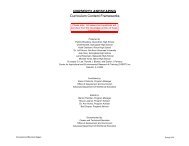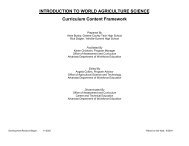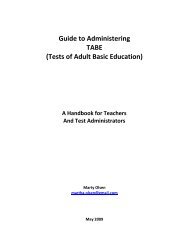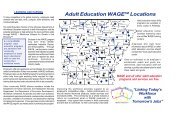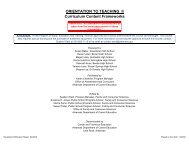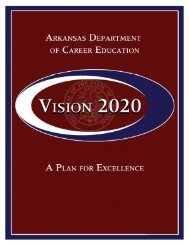JAG Program Information - Arkansas Department of Career Education
JAG Program Information - Arkansas Department of Career Education
JAG Program Information - Arkansas Department of Career Education
Create successful ePaper yourself
Turn your PDF publications into a flip-book with our unique Google optimized e-Paper software.
PROGRAM<br />
INFORMATION<br />
DEPARTMENT OF CAREER EDUCATION<br />
JOBS FOR ARKANSAS’ GRADUATES<br />
(<strong>JAG</strong>)
<strong>Department</strong> <strong>of</strong> <strong>Career</strong> <strong>Education</strong><br />
Three Capitol Mall, Room 401<br />
Little Rock, AR 72201-1083<br />
Telephone: (501) 682.1535<br />
Fax: (501) 682.1805<br />
E-mail: marylene.tate@arkansas.gov<br />
valerie.spivey@arkansas.gov<br />
William L. “Bill” Walker, Jr. Director <strong>Career</strong> <strong>Education</strong><br />
John Davidson, Deputy Director <strong>Career</strong> <strong>Education</strong><br />
Sandra Porter, Associate Director <strong>Career</strong> <strong>Education</strong><br />
Marylene Tate, <strong>Program</strong> Manager<br />
Valerie Spivey, <strong>Program</strong> Support<br />
2
I. PROGRAM DESCRIPTION<br />
PROGRAM INFORMATION<br />
Jobs for <strong>Arkansas</strong>’ Graduates (<strong>JAG</strong>)<br />
Job’s for <strong>Arkansas</strong>’ Graduates (<strong>JAG</strong>) is a broad based School-to-Work program<br />
designed to assist students whose ability to successfully graduate from high<br />
school and obtain meaningful employment is in jeopardy. The program’s goal is<br />
to ensure student’s graduation (or GED) and prepare students for workplace<br />
success whether their career begins immediately upon high school graduation or<br />
requires them to complete postsecondary education/training.<br />
II.<br />
COURSE DESCRIPTION AND CONTENT<br />
A. Course Description<br />
Jobs for <strong>Arkansas</strong>’ Graduates can be utilized in any program <strong>of</strong> study and can<br />
count as credit toward a student’s vocational career focus/major. The program’s<br />
goal is to ensure student graduation (or GED) and prepare students for<br />
workplace success whether their career begins immediately upon high school<br />
graduation, includes entry into military service, or requires them to complete<br />
postsecondary education/training.<br />
B. Course Content<br />
The course will consist <strong>of</strong> the following areas:<br />
1. <strong>Career</strong> Development Skills<br />
2. Job Attainment Skills<br />
3. Job Survival Skills<br />
4. Basic Skills<br />
5. Leadership and Self-development Skills<br />
6. Life Survival Skills<br />
7. Workplace Skills<br />
The model requires the completion <strong>of</strong> the 37 core competencies. The curriculum<br />
contains a total <strong>of</strong> 87 competencies. <strong>Arkansas</strong> requires the completion <strong>of</strong> 40<br />
(including core) competencies for School-to-<strong>Career</strong> (senior only) participants and<br />
50 (including core) competencies for Dropout Prevention (multiyear) participants.<br />
C. Required Instructional Methods<br />
1. Hands-on Activities (minimum <strong>of</strong> one activity per unit)<br />
2. Audio-Visual Aids<br />
3. Resource Speakers<br />
4. Field Trips<br />
5. Lectures<br />
6. Occupational Research (including the <strong>Arkansas</strong> Occupational and<br />
<strong>Education</strong>al <strong>Information</strong> System – AOEIS)<br />
3
III.<br />
BACKGROUND INFORMATION<br />
Jobs for America’s Graduates (<strong>JAG</strong>) is a nonpr<strong>of</strong>it corporation established to promote<br />
business interaction in schools. It was initiated as a “pull out” program utilizing business<br />
people as specialists (instructors). <strong>JAG</strong> was established 20 years ago in Delaware and<br />
is now established in 27 states.<br />
The model has 10 components, which must be maintained by the state affiliate. The<br />
components are<br />
Oversight Board<br />
<strong>Program</strong> Management<br />
<strong>Program</strong> Staff<br />
Participant Selection<br />
Student Load<br />
<strong>Career</strong> Association<br />
Competency Attainment<br />
Employer Marketing and Job Development<br />
Follow-up Services<br />
National Database Participation<br />
The model has three program applications or ways to utilize it<br />
School-to-<strong>Career</strong> (senior only) (12 th -grade students only)<br />
Dropout Prevention (multi-year)<br />
Dropout Recovery<br />
There are five primary performance goals <strong>of</strong> the School-to-<strong>Career</strong> and Dropout<br />
Prevention Applications<br />
• 90% graduation/GED rate;<br />
80% overall success rate at the end <strong>of</strong> 12 months after graduation, with<br />
participants either employed in a job leading to a career, in the military, or<br />
enrolled in a postsecondary education or training, or a combination <strong>of</strong> work and<br />
postsecondary education;<br />
60% <strong>of</strong> graduates are employed;<br />
60% <strong>of</strong> employed graduates are in full-time jobs leading to careers; and<br />
80% <strong>of</strong> the graduates are employed full-time or are combining work and school.<br />
These goals are to be achieved by the third year <strong>of</strong> operation.<br />
<strong>Arkansas</strong> high schools and alternative schools wishing to implement Jobs for <strong>Arkansas</strong>’<br />
Graduates (<strong>JAG</strong>) may apply for DWE New <strong>Program</strong> Start-up funds to operate the<br />
School-to-<strong>Career</strong> application or the Dropout Prevention application for 11-12 th grades<br />
(senior only).<br />
IV.<br />
EQUIPMENT LIST<br />
1. Furniture<br />
a. Work tables<br />
b. Chairs (25% are to be adjustable)<br />
c. Teacher desk<br />
d. Teacher chair<br />
4
e. Shelves<br />
f. Storage cabinet<br />
g. Printer stands<br />
h. File cabinet (lockable)<br />
2. Equipment<br />
a. Microcomputers – latest technology<br />
b. S<strong>of</strong>tware<br />
c. Printers (Laser with 4 MB memory or ink jet printer)<br />
d. VCR or DVD and TV<br />
e. Scanner<br />
f. Screen<br />
g. Telephone or telephone jack<br />
h. Headphones<br />
i. Calculators<br />
j. Bulletin board<br />
k. Dry erase board<br />
l. Camera<br />
V. SUPPLEMENTAL INSTRUCTIONAL MATERIALS AND SUPPLIERS<br />
1. Classroom set <strong>of</strong> any <strong>of</strong> the following:<br />
a. Succeeding in the World <strong>of</strong> Work – Revised, 1998<br />
Glencoe Division <strong>of</strong> MacMillan/McGraw-Hill<br />
P.O. Box 508<br />
Columbus, OH 43216<br />
1-800-828-5096<br />
b. From School to Work – Revised, 2000<br />
Goodheart-Wilcox Publisher<br />
18604 W. Creek Dr.<br />
Tinley Park, IL 60477-6243<br />
1-800-323-0440<br />
c. Workmatters – 1997<br />
Contemporary Books<br />
4255 W. Touhy Ave.<br />
Lincolnwood, IL 60646-1975<br />
1-800-323-4900<br />
d. Dynamics <strong>of</strong> Work – 1998<br />
South-Western <strong>Education</strong>al Publishing<br />
5101 Madison Road<br />
Cincinnati, OH 45227-1490<br />
1-800-354-9706<br />
VI.<br />
FACILITIES<br />
Classroom size shall conform to the Standards for Accreditation <strong>of</strong> Public Schools;<br />
however, enrollments may vary and will depend on the availability <strong>of</strong> equipment, tools,<br />
furniture, and instructional materials that support the program.<br />
5
Additionally, safety conditions are a consideration in the class size established.<br />
Jobs for America’s Graduates requests that a business atmosphere be stressed in the<br />
classroom. Tables are preferred rather than individual desks. The classroom should be<br />
<strong>of</strong> sufficient size for hands-on activities.<br />
One electrical outlet for every six feet <strong>of</strong> wall space should be provided.<br />
A minimum <strong>of</strong> 100 square feet <strong>of</strong> portable or stationary storage should be provided for<br />
each classroom to house equipment, supplies, teacher materials, student records, and<br />
files.<br />
It is recommended that the following minimum requirements be designed:<br />
Area Size Square Feet Number Needed Total Sq. Ft. Area Use<br />
5 x 5 25 25 625 Student Area<br />
10 x 10 100 1 100 Equipment and Storage<br />
10 x 10 100 1 100 Teacher Area<br />
825 Total Sq. Ft.<br />
Adequate lighting enables students to read fine print at desk level. Consideration should<br />
be given to glare problems associated with equipment using screens. Shades may be<br />
needed since, regardless <strong>of</strong> the room arrangement, glare will be a factor.<br />
Microcomputer systems should not be placed near heating or cooling units or located so<br />
that students face windows without shades.<br />
VII.<br />
TEACHER QUALIFICATIONS<br />
The specialist is to be secondary certified in a vocational or any core academic area and<br />
endorsed through the completion <strong>of</strong> program management training developed and<br />
approved by the <strong>Department</strong> <strong>of</strong> <strong>Career</strong> <strong>Education</strong>. Training includes New Specialist<br />
Training (one to two days) and National Data Management System training (one day).<br />
(Existing GCE, CCE, and CCVE coordinators and instructors are eligible to “grandfather”<br />
into the program by completing the designated program management training.)<br />
VIII.<br />
CONTRACT LENGTH<br />
It is strongly recommended that, during the first year <strong>of</strong> operation, the specialist be<br />
employed on a contract <strong>of</strong> a minimum <strong>of</strong> 215 days. It also is strongly recommended that<br />
during each subsequent year, the specialist be employed on a contract <strong>of</strong> a minimum <strong>of</strong><br />
225 days.<br />
The model requires 12 months <strong>of</strong> follow-up after graduation, which means monthly<br />
contact with participant beginning the month <strong>of</strong> June following graduation and at least six<br />
contacts with the participant’s employer/school/military recruiter.<br />
6
IX.<br />
PROFESSIONAL DEVELOPMENT ACTIVITIES<br />
Teachers are encouraged to participate in all in-service training workshops, quarterly<br />
meetings, National Training Seminar, and the following pr<strong>of</strong>essional organizations:<br />
X. FUNDING<br />
Association <strong>of</strong> <strong>Career</strong> <strong>of</strong> <strong>Career</strong> & Technical Educators (Special Needs Division)<br />
National Association <strong>of</strong> Vocational <strong>Education</strong> Special Needs Personnel<br />
<strong>Arkansas</strong> Association <strong>of</strong> Vocational <strong>Education</strong> Special Needs Personnel<br />
The <strong>Arkansas</strong> <strong>Career</strong> Investment Board (WIB) endorses the <strong>JAG</strong> program. A few local WIBs<br />
provide supplemental funding for <strong>JAG</strong> programs.<br />
New program start-up equipment funds are available. Supplemental funding through<br />
local <strong>Career</strong> Investment Youth Councils may be utilized.<br />
XI.<br />
CLASS GRADE LEVEL & LENGTH<br />
Jobs for <strong>Arkansas</strong>’ Graduates is designed as a School-to-<strong>Career</strong> Application or as<br />
Dropout Prevention Application (11–12th grade) program.<br />
Eleventh -or 12 th -grade career and technical students with two or more identified barriers<br />
shall apply for acceptance to the program. The specialist identifies a student’s barriers<br />
prior to placement into the program. Students are to have an identified career and<br />
technical focus/major and have completed at least one unit and be enrolled in a second<br />
unit <strong>of</strong> the identified career focus/major. Alternative schools that don’t <strong>of</strong>fer or have<br />
access to career and technical education request a waiver.<br />
The model requires 35-45 students be the maximum in the in-school phase. <strong>Program</strong>s<br />
in alternative schools can request a waiver to lower the student load. <strong>Arkansas</strong> <strong>JAG</strong><br />
recommends that the specialist be provided one period for Employer Marketing and Job<br />
Development for every 25 in-school participants.<br />
Class periods shall conform to the minimum class hours established by the Standards<br />
for Accreditation <strong>of</strong> Public Schools and North Central Association (NCA). (NCA: 120<br />
hours = 1 unit; 60 hours = ½ unit)<br />
One unit <strong>of</strong> credit per year is to be given for Jobs for <strong>Arkansas</strong>’ Graduates participants.<br />
A student’s maximum length <strong>of</strong> enrollment in the program shall be two years, depending<br />
on the application <strong>of</strong> the model. <strong>JAG</strong> may be utilized as a related option <strong>of</strong> any program<br />
<strong>of</strong> study. It is not a stand-alone program <strong>of</strong> study or career focus/major.<br />
Part-time employment is not a requirement <strong>of</strong> the <strong>JAG</strong> program, but credit can be given<br />
at the discretion <strong>of</strong> the individual school district. Schools that grant credit for work-based<br />
learning shall follow the course credit guidelines for the <strong>Career</strong> <strong>Education</strong> Internship<br />
program.<br />
7
XII.<br />
CLASS SIZE<br />
“Standards <strong>of</strong> Accreditation”, <strong>Arkansas</strong> Public Schools states: “in grades seven through<br />
twelve, a teacher shall not be assigned more than one hundred fifty (150) students daily<br />
and an individual class shall not exceed thirty (30) students, provided that, in exceptional<br />
cases or for courses that lend themselves to large group instruction, these ratios may be<br />
increased.” (<strong>JAG</strong> is not an exceptional case). Large <strong>JAG</strong> classes have proven to be<br />
less practical and effective because they place limitations on the types and quality <strong>of</strong><br />
hands-on, individualized, or other class activities.<br />
XIII.<br />
ADVISORY COMMITTEE<br />
Sites are to develop a local advisory board with representatives <strong>of</strong> groups such as:<br />
educational providers (e.g., adult education, GED instructors, community college<br />
representatives, School-to-Work partnerships), community agencies (e.g., homeless<br />
shelters, mental health services, <strong>Career</strong> development, and juvenile <strong>of</strong>ficers), and school<br />
personnel.<br />
The selection committee, a subcommittee <strong>of</strong> the local advisory board, shall be local and<br />
accept responsibility for program participants targeted for services. The selection<br />
committee shall be comprised <strong>of</strong> selected representatives <strong>of</strong> the local school system<br />
(e.g., high school administrators, counselors, vocational faculty, and academic faculty).<br />
XIV.<br />
STUDENT ORGANIZATION<br />
Alternative schools must operate a local career association.<br />
While National Jobs for America’s Graduates’ (<strong>JAG</strong>) asks that elements <strong>of</strong> their career<br />
association (National <strong>Career</strong> Association) be included in the curriculum, specialists will provide<br />
support to the students and advisors in the student’s career focus career and technical student<br />
organization. <strong>JAG</strong> students are strongly encouraged to hold membership in the student<br />
organization that represents their chosen career focus/major area. The specialists will assist<br />
the <strong>JAG</strong> students in the activities <strong>of</strong> their chosen CTSO. NCA or “club-like” activities can be<br />
utilized as a classroom management tool.<br />
8
*<strong>JAG</strong> Core Competencies<br />
JOBS FOR AMERICA’S GRADUATES, INC.<br />
<strong>JAG</strong> NATIONAL CURRICULUM COMPETENCIES<br />
*A. <strong>Career</strong> Development Competencies<br />
A.1 Identify occupational interests, aptitudes and abilities.<br />
A.2 Relate interests, aptitudes and abilities to appropriate occupations.<br />
A.3 Identify desired life style and relate to selected occupations.<br />
A.4 Develop a career path for selected occupations.<br />
A.5 Select an immediate job goal.<br />
A.6 Describe the conditions and specifications <strong>of</strong> the job goal.<br />
*B. Job Attainment Competencies<br />
B.7 Construct a resume.<br />
B.8 Conduct a job search.<br />
B.9 Develop a letter <strong>of</strong> application.<br />
B.10 Use the telephone to arrange an interview.<br />
B.11 Complete application forms<br />
B.12 Complete employment tests.<br />
B.13 Complete a job interview.<br />
*C. Job Survival Competencies<br />
C.14 Demonstrate appropriate appearance.<br />
C.15 Understand what employers expect <strong>of</strong> employees.<br />
C.16 Identify problems <strong>of</strong> new employees.<br />
C.17 Demonstrate time management.<br />
C.18 Follow directions.<br />
C.19 Practice effective human relations.<br />
C.20 Appropriately resign from a job.<br />
*D. Basic Competencies<br />
D.21 Comprehend verbal communications.<br />
D.22 Comprehend written communications.<br />
D.23 Communicate in writing.<br />
D.24 Communicate verbally.<br />
D.25 Perform mathematical calculations.<br />
*E. Leadership and Self Development Competencies<br />
E.26 Demonstrate team membership.<br />
E.27 Demonstrate team leadership.<br />
E.28 Deliver presentations to a group.<br />
E.29 Compete successfully with peers.<br />
E.30 Demonstrate commitment to an organization.<br />
*F. Personal Skills Competencies<br />
F.31 Understand types <strong>of</strong> maturity.<br />
F.32 Identify a self-value system and how it affects life.<br />
F.33 Base decisions on values and goals.<br />
**<strong>JAG</strong> Prescribed Competencies<br />
9
F.34 Identify process <strong>of</strong> decision-making.<br />
F.35 Demonstrate ability to assume responsibility for actions and decisions.<br />
F.36 Demonstrate a positive attitude.<br />
F.37 Develop healthy self-concept for home, school and work.<br />
**G. Life Survival Skills<br />
G.38 Evaluate a career plan to determine appropriate postsecondary educational options.<br />
G.39 Identify how best to achieve marketable occupation skills for an entry level job.<br />
G.40 Conduct a job analysis.<br />
G.41 Apply critical thinking skills.<br />
G.42 Demonstrate effective study skills.<br />
G.43 Demonstrate how to use group dynamics techniques.<br />
G.44 Explain the roles and function <strong>of</strong> a value-added organization.<br />
G.45 Understand the essential elements <strong>of</strong> high performing work teams.<br />
G.46 Describe how to work and communicate with diverse people at work and in the community to<br />
satisfy their<br />
expectations.<br />
G.47 Demonstrate techniques for building commitment by others.<br />
G.48 Demonstrate an openness to change.<br />
G.49 Provide constructive feedback.<br />
G.50 Negotiate solutions to conflicts.<br />
G.51 Demonstrate politeness and civility.<br />
G.52 Demonstrate an ability to adapt to people and situations.<br />
G.53 Exhibit work ethics and behaviors essential to success.<br />
G.54 Set and prioritize goals and establish a timeline for achieving them.<br />
G.55 Apply the problem solving process to complex problems.<br />
G.56 Demonstrate an ability to analyze the strengths and weaknesses <strong>of</strong> self and others.<br />
G.57 Design and justify solutions by tracking and evaluating results.<br />
G.58 Identify ways to build mutual trust and respect.<br />
G.59 Prepare a short- and long-term personal budget.<br />
**H. Work Place Competencies<br />
H.60 Demonstrate punctuality and good attendance practices.<br />
H.61 Demonstrate initiative and pro-activity.<br />
H.62 Demonstrate how to work effectively with others.<br />
H.63 Demonstrate an attitude that attracts the attention <strong>of</strong> management.<br />
H.64 Demonstrate an ability to communicate and work with customers to satisfy their expectations.<br />
H.65 Demonstrate listening skills which will result in gaining a clear understanding <strong>of</strong> information<br />
being conveyed.<br />
H.66 Demonstrate an ability to follow and give directions.<br />
H.67 Demonstrate good reasoning skills which results in thinking first, then taking action.<br />
H.68 Demonstrate integrity and honesty in dealings with internal and external customers.<br />
H.69 Demonstrate a willingness to accept responsibility for one’s own actions.<br />
H.70 Demonstrate a commitment in completing work assignments accurately and in a timely fashion.<br />
H.71 Demonstrate an ability to satisfy the purposes <strong>of</strong> a delegated task..<br />
H.72 Demonstrate an ability to prioritize and manage time effectively in the workplace.<br />
H.73 Demonstrate enthusiasm for work.<br />
H.74 Demonstrate an eagerness to learn new responsibilities or improve current responsibilities.<br />
H.75 Demonstrate an understanding <strong>of</strong> the work to be accomplished.<br />
H.76 Demonstrate familiarity with a variety <strong>of</strong> techniques.<br />
10
H.77 Demonstrate an ability to self-evaluate and develop a continuous improvement (career<br />
development) plan.<br />
H.78 Demonstrate basic computer operation skills.<br />
H.79 Demonstrate an ability to learn from past experiences and others.<br />
H.80 Demonstrate an ability to send, receive and organize e-mail messages.<br />
H.81 Demonstrate an ability to search for information on the Internet.<br />
**I. Economic Empowerment Competencies<br />
I.82 Understand Insurance--Auto, Renters, Home, Health, Disability and Life (Allstate)<br />
I.83 Practice Better Money Management Skills (Visa U.S.A)<br />
I.84 Demonstrate How to Start a Small Business (Allstate)<br />
I.85 Be successful in dealing with law enforcement when they are enforcing the law (Allstate)<br />
I.86 Value Diversity (Allstate)<br />
I.87 Plan wisely for the future and Live Smart (Allstate and NCEE)<br />
<strong>JAG</strong> National Headquarters<br />
1729 King Street, Suite 100<br />
Alexandria, VA 22314-2720<br />
Tel. 703.684.9489<br />
<strong>JAG</strong> National Center for Evidence-Based Practices<br />
6021 Morriss Road, Suite 111<br />
Flower Mound, TX 75028<br />
Tel. 972.691.4486<br />
E-mail: jag@jag.org<br />
www.jag.org<br />
11



